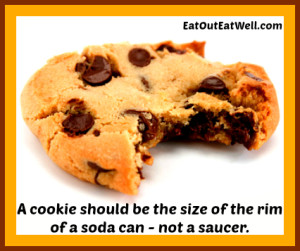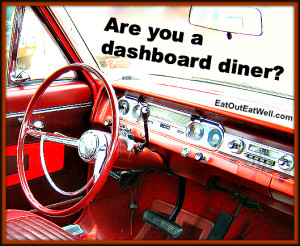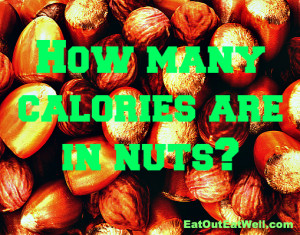- A chocolate chip cookie—or oatmeal raisin for that matter—should be about the size of the rim of a soda can. Some cookies are four times that size—and with four times the calories and fat content!
- Don’t be duped by turkey, fish, and veggie burgers and sandwiches. They sound healthier and less caloric than beef, but that might not be the case. At Red Robin a grilled turkey burger has 578 calories, 29g fat. Burger King’s Premium Alaskan Fish sandwich has 530 calories, 28g fat while a Whopper Jr. without mayo has 260 calories, 10g fat. A Sedona Black Bean Burger at TGI Fridays has 870 calories, 49g fat.
- Bottled water isn’t always just water. Some are just water or water with flavor essence but lots of them are naturally or artificially sweetened, flavored, and colored. Don’t be duped. For instance, many Vitaminwater flavors have 50 calories in a serving (8 ounces), but the bottles are usually 20 ounces which makes the contents around 120 calories and 30+ grams of sugar. There are no-calorie Vitaminwater Zeros, too.
- Skip the bran muffin for breakfast. We think bran muffins are “healthy” because they have the word bran in their name, but they’re actually made with a lot of sugar and fat. A Dunkin’ Donuts Honey Bran Raisin Muffin has 480 calories with 15 grams of fat and 79 grams of carbs (it does, however, have 5 grams of fiber). In general, a 4 ounce bran muffin has around 350 calories—but, have you seen the size of most muffins—they sure don’t tip the scales at 4 ounces.
- Cans and boxes that look like single servings may have two or three. They may look small enough to be for one, but that doesn’t mean it’s true. Check out how many servings are in your can of soup or box of mac and cheese.
3 Easy Barbecue and Picnic Tips To Avoid Overeating
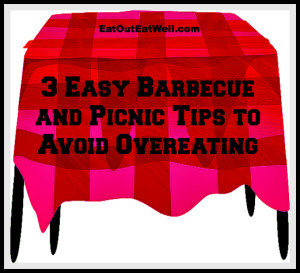 1. If you’re full, stop eating and clear your plate right away. If it hangs around in front of you, you’ll keep picking at it until there’s nothing left. An exception – a study has found that looking at the “carnage” – the leftover bones from barbecued ribs or even the number of empty beer bottles – can serve as an “environmental cue” to stop eating.
1. If you’re full, stop eating and clear your plate right away. If it hangs around in front of you, you’ll keep picking at it until there’s nothing left. An exception – a study has found that looking at the “carnage” – the leftover bones from barbecued ribs or even the number of empty beer bottles – can serve as an “environmental cue” to stop eating.
2. Do you really need to stand in front of the picnic table, kitchen table, or barbecue? The further away from the food you are the less likely you are to eat it. Don’t sit or stand where you can see the food that’s calling your name. Keep your back to it if you can’t keep distant. There’s just so much control you can exercise before “see it = eat it.” If staying near the food gets to be too much, go for a walk, a swim, or engage someone in an animated conversation. It’s pretty hard to shove food in your mouth when you’re busy talking.
3. Before you grab some tasty ribs, dogs, burgers or pie — ask yourself if you really want it. Are you hungry? Is it worth the calories? Odds are, the tempting display of food in front of you is visually seductive – and may smell great, too — but you’re reaching out to eat what’s in front of you for reasons not dictated by your stomach but by your eyes. Have you decided that you want to splurge on something specific? Try picking it ahead of time and commit to your choice so you don’t find yourself wavering in the face of temptation.
Dashboard Diner: What Is It And Are You One?
How many ketchup drips, chocolate smears, coffee stains, and random crumbs do you have in your car (or on your clothes)?
Is your road trip to the shore or mountains or the big game an endless fest of fast food, junk food, and all kinds of snacks with your dashboard or vacant passenger seat as your table?
If you’re nodding your head, you’re a dashboard diner.
It’s way too easy to indulge your dashboard dining gremlin when doughnut shops and fast food restaurants have drive-thruus and gas stations come equipped with mini-marts that serve that comes regular,, decaf, dark velvet and hazelnut coffee and baked goods so your coffee doesn’t get lonely.
Mini-Mart And Rest-Stop “Gotchas”
Candy:
Candy is an impulse purchase; 49 percent of shoppers admit to unplanned purchases of candy. We want to treat ourselves and candy is an affordable luxury. Chocolate bars are the main choice — followed by gum; bagged, repacked peg candy; candy rolls; mints and drops; non-chocolate bars; seasonal candy and novelties.
Check out the placement of candy the next time you’re in a mini-mart or convenience store. It’s positioned to grab your attention. Its vividly colored wrappers reach out to you from high-traffic areas of the store: the checkout area, the aisle that leads to the check out, and on the way to the restrooms. Know that your senses are going to be assaulted and have a plan for what you will and will not buy. If you’ve decided you want M&Ms go straight to them and don’t get sidetracked by a new kind of chips, or seasonal displays, or the latest and greatest deal on a king– sized package of some kind of candy.
Coffee:
Unlike candy, coffee isn’t an impulse purchase. Nearly 96% of customers intend to buy a cup of coffee before they walk in. That’s why the stores put impulse-buy merchandise —candy, baked goods, and chips — near the coffee to entice you to buy them. As a man standing in line at a popular gas station mini-mart muttered, “I stop here for coffee every morning and I’ve gained 20 pounds since they put in the Krispy Kreme donut display between the door and the cash register.”
Some Helpful Tips:
- Go for the nuts got protein and crunch, won’t cause swings in your blood sugar and are almost always stocked. Tread a little gently —
nuts are not low in fat or calories. - Some mini-marts have fruit (oranges and bananas come in their own natural wrapper and don’t have to be washed) and almost all have dried fruit
- Sometimes you can find individual bowls of Cheerios or whole grain cereals. Grab a small container of non or
low-fat milk or a container of yogurt. - Popcorn is a great choice and some stations stock fat-free soy crisps or pop chips. Be aware of portion sizes. Sometimes a bag has more than one serving.
- Protein bars can be good, better, and best. Check the labels for higher protein and lower sugar. Some can be the equivalent of a candy bar and are so large (with so many calories) that they are made to be meal replacements.
- If you’re really hungry choose a sandwich or burrito over donuts, pastry, and cookies. Check out how fresh it is, though. What’s appealing early in the morning when the shelves are first stocked might not be so appealing at 10PM if it has sat around all day and lots of people have picked up the sandwich, squeezed it, and put it back again.
- Beef jerky or beef sticks (or nuggets) are good, portable
protein snacks. A 1-ounce serving can have around 80 calories and 3 grams of fat or less. A hard– - If you must go with crunchy stuff, stick with pretzels or look for baked or popped chips. Look for single-serve bags to keep portions in check. Remember that the salty stuff will make you thirsty so stock up on water. There’s something to be said for snacks that take time to eat one by one when you’re driving.
- It may take away some of the road trip spontaneity, but when you pack up your car you can pack some food, too. Fill a cooler with water, fruit, yogurt, sandwiches — hatever you think you will eat and that will keep you alert and energized (aim for some complex carbs and protein). Why not throw in someportion
Planning ahead means you’re not at the mercy of the vending machines and racks and racks of candy, chips, and baked goods. - Use an app or your GPS to find nearby restaurants as you drive through various communities. A little searching can help you find places with healthier options than you might find at a rest stop. This can be really helpful for anyone with allergies or special dietary requirements.
- If you just want to leave your rest stop purchases to chance at least have your own mental list of some good, better, and best choices of food to buy. The danger is that the candy, chips, fries, and doughnuts call your name the minute you walk in the door. If you know that you’re going to head straight for the nuts, or popcorn, or even a burger, that’s great, as long as the giant chocolate chip cookie and the bargain 32–
ounce soda for 99 cents doesn’t grab you first. Try to decide what you’re going to buy - Remember that too much sugar causes a spike and then nose dive of your blood sugar levels. The consequence is that you’re initially energized and then can get very drowsy and unfocused as your blood sugar plummets. Not exactly what you want when you’re driving.
How Many Calories Are In Different Kinds Of Nuts?
Nuts are full of healthy fats and protein. They’re a great snack and can help tide you over until your next meal — but they’re also a high calorie food.
Be careful of portions — a serving size of most nuts is one ounce.
For a one ounce serving:
- 49 shelled pistachios, 162 calories
- 23 almonds, 169 calories
- 21 hazelnuts, 183 calories
- 18 cashews, 163 calories
- 19 pecans, 201 calories
- 14 English walnut halves, 185 calories
- 10-12 macadamias, 203 calories
- 39 peanuts (technically a legume), dry roasted, 170 calories
A Dozen Really Common Reasons We Eat When We’re Not Hungry
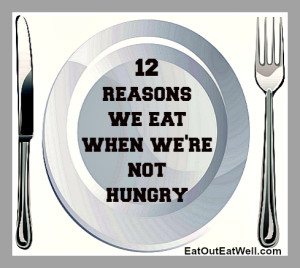 Eating when you’re not hungry, or when you’re bored, angry, tired, procrastinating, or celebrating can push your calorie intake way up.
Eating when you’re not hungry, or when you’re bored, angry, tired, procrastinating, or celebrating can push your calorie intake way up.
The biggest problem is that we often don’t realize that we’re shoving food into our mouths – either because we’re distracted, we don’t want to know, or we just plain old don’t care.
What Makes Us Do It?
1. “Cheap” calories: the kind you find at all you can eat restaurants, freebie tastes in markets, the basket of broken cookies in the bakery, and “value and super sized meals.”
2. Bread and extras like butter, olive oil, and olives on the table or bar peanuts or pretzels. Way too tempting to pass up – especially if you’re hungry or you’ve walked in with the attitude that you “deserve” it because you’ve had a tough day.
3. Walking into your kitchen or the snack room at work and having your favorite snacks staring you in the face (see it = eat it).
4. Procrastinating or avoiding doing what you have to do by having a snack.
5. Watching TV with a bag of chips or a bowl of candy on your lap.
6. Parties— especially when you drink — causing you to lose count and control of what you’re grabbing to eat.
7. Food and coffee shops on every corner that offer lots of food, lots of variety, and are open all the time.
8. The in(famous) sugar/fat/salt combination in baked goods, fast food, candy, fast food, frozen food, and processed food.
9. Food that your family or roommates insist must be in the house – or that you think they want in the house.
10. Feeling tired, stressed, overwhelmed, bored, angry, or “out-of-sorts” and turning to food as a “pick-me-up” or for comfort.
11. Mindless bites – a piece of candy from the open bowl on a desk, a taste of your partner’s dessert, finishing your child’s food (especially dripping ice cream cones).
12. Being a member of the clean plate club – which also extends to polishing off leftovers and finishing the last bits left in the pan or serving dishes as you clean up.
